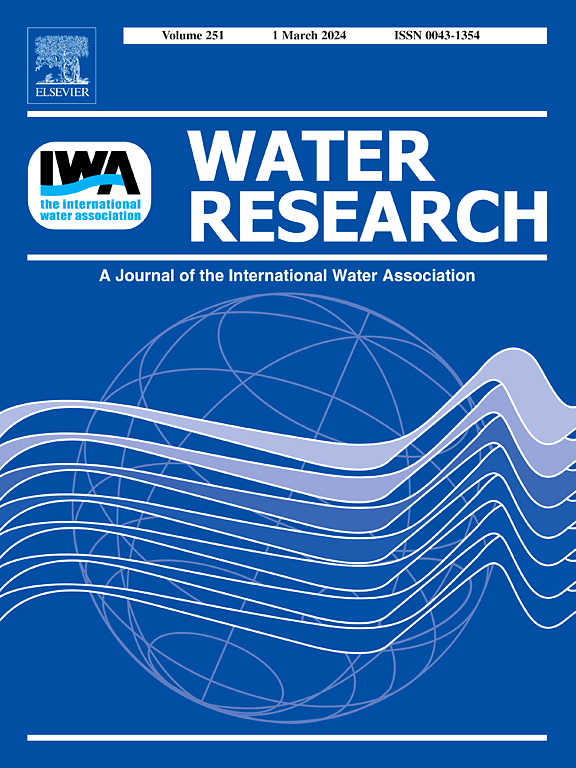Operational Control Strategy on Optimal Calcium Removal in Drinking Water Treatment Processes: Insights from Reactor Experiments, Modelling and Particle Characterization
IF 11.4
1区 环境科学与生态学
Q1 ENGINEERING, ENVIRONMENTAL
引用次数: 0
Abstract
Drinking water softening is an essential treatment step that provides multiple benefits, including public health, reduction of environmental impact, decrease in clogging potential and improvement in heating efficiency. With approximately 35 billion cubic meter of water being softened annually worldwide, the predominant methods are conventional lime/soda-ash softening, nanofiltration, ion exchange, and seeded crystallization through pellet-water softening. This study addresses the limitations in existing predictive models for calcium carbonate (CaCO3) precipitation kinetics in industrial-scale pellet-water softening by experimentally investigating the integral and multivariate effects of particle-, fluid-, water matrix- and reactor properties, on CaCO₃ precipitation kinetics. Fluid characterization experiments were conducted at lab-scale continuous-stirred tank reactors (CSTR), pilot-scale plug-flow reactors (PFR), and full-scale fluidized bed reactors (FBR) at the Waternet Weesperkarspel treatment plant in Amsterdam, The Netherlands, while solid characterization was performed with image analysis software and SEM on pellets and water samples collected during FBR experiments. The calcium removal data obtained from experiments were compared with modeled CaCO3 precipitation rates using and extending the most recently developed water softening model for pellet-water softening. The results predominantly highlight the critical role of mixing dynamics — between softening chemicals, hard influent water and seeding material — for accurate CaCO3 precipitation predictions across various reactor types and other reactor-specific properties such as the residence time of influent hard water. Additional enhancements can be achieved by targeting fluid properties, followed by water matrix properties, and finally particle properties, though these factors exhibit a progressively smaller impact on overall water softening improvement. By implementing these prioritized optimization strategies, the operational control strategy for calcium removal will be enhanced, leading to improvements in cost-effectiveness, sustainability, and reliability in drinking water treatment processes.

求助全文
约1分钟内获得全文
求助全文
来源期刊

Water Research
环境科学-工程:环境
CiteScore
20.80
自引率
9.40%
发文量
1307
审稿时长
38 days
期刊介绍:
Water Research, along with its open access companion journal Water Research X, serves as a platform for publishing original research papers covering various aspects of the science and technology related to the anthropogenic water cycle, water quality, and its management worldwide. The audience targeted by the journal comprises biologists, chemical engineers, chemists, civil engineers, environmental engineers, limnologists, and microbiologists. The scope of the journal include:
•Treatment processes for water and wastewaters (municipal, agricultural, industrial, and on-site treatment), including resource recovery and residuals management;
•Urban hydrology including sewer systems, stormwater management, and green infrastructure;
•Drinking water treatment and distribution;
•Potable and non-potable water reuse;
•Sanitation, public health, and risk assessment;
•Anaerobic digestion, solid and hazardous waste management, including source characterization and the effects and control of leachates and gaseous emissions;
•Contaminants (chemical, microbial, anthropogenic particles such as nanoparticles or microplastics) and related water quality sensing, monitoring, fate, and assessment;
•Anthropogenic impacts on inland, tidal, coastal and urban waters, focusing on surface and ground waters, and point and non-point sources of pollution;
•Environmental restoration, linked to surface water, groundwater and groundwater remediation;
•Analysis of the interfaces between sediments and water, and between water and atmosphere, focusing specifically on anthropogenic impacts;
•Mathematical modelling, systems analysis, machine learning, and beneficial use of big data related to the anthropogenic water cycle;
•Socio-economic, policy, and regulations studies.
 求助内容:
求助内容: 应助结果提醒方式:
应助结果提醒方式:


